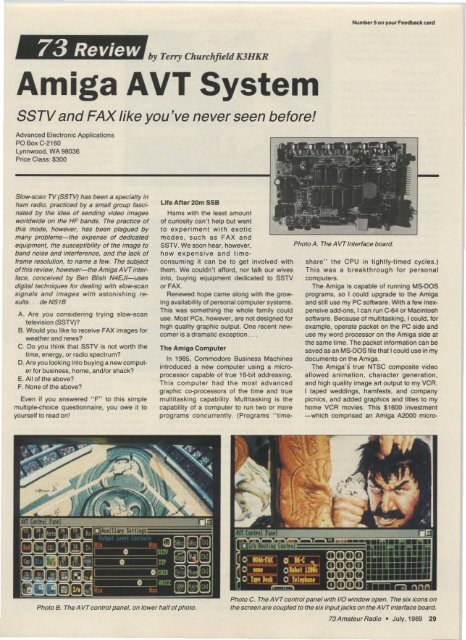am..Brew
T'JTJ~~~ - Free and Open Source Software
T'JTJ~~~ - Free and Open Source Software
- No tags were found...
Create successful ePaper yourself
Turn your PDF publications into a flip-book with our unique Google optimized e-Paper software.
73 Review by Terry Churchfield K3HKR<br />
Number 9 on yotlr FNd~ k uord<br />
Amiga A VT System<br />
SSTVand FAX like you've never seen before!<br />
Advanced Electronic Applications<br />
PO Box C·2 160<br />
l ynnwood, WA 98036<br />
Price Class: 5300<br />
Slow·scan TV ($ S TV) has been a specialty in<br />
h<strong>am</strong> radio, practiced by a small group tesonsted<br />
by the idea of sending video images<br />
worldwide on the HF bands. The practice of<br />
this mode, however, has been plagued by<br />
many problems-the expense of dedicated<br />
equipment, the susceptibility of the image to<br />
band noise and interference, and the lack of<br />
fr<strong>am</strong>e resolution, to n<strong>am</strong>e 8 few. The subject<br />
ofthis review, however-the Amiga A VT interface,<br />
conceived by Ben Blish N4EJI-uses<br />
digital techniques for dealing with slow-scan<br />
signals and images with aston ishing reo<br />
suits ...deNS'S<br />
A. Are you considering trying slow-scan<br />
television (SSTV)?<br />
B. Would you like to receive FAX images for<br />
weather and news?<br />
C. Do you think that SSTV is nol worth Ihe<br />
time, energy, or radio spectrum?<br />
D. Areyou lOOking into buying a new computer<br />
lor business, home, andlor shack?<br />
E . All 01the above?<br />
F. None ol the above?<br />
Even if you answered " F" 10 th is simpl e<br />
multiple-choice questionnaire, you owe it to<br />
yourself to read on!<br />
Life After 20m sse<br />
H<strong>am</strong>s with the least <strong>am</strong>ounl<br />
of curiosity can't help but want<br />
10 experiment with exotic<br />
modes, such as FA X and<br />
SSTV. We soon hear, however,<br />
how expensive and um e-<br />
consuming it can be to get involved with<br />
them. We couldn't afford. nor talk our wives<br />
into, buying equipment dedicated 10 SSTV<br />
or FAX.<br />
Renewed hope c<strong>am</strong>e along with the growing<br />
availabuity 01 personal computer systems.<br />
This was something the whole f<strong>am</strong>ily could<br />
use. Mosl Pes, however, are not designed lor<br />
high quality graphic output. One recent newcomer<br />
is a cremate exception...<br />
The Amiga Computer<br />
In 1985, Commodore Business Machines<br />
introduced a new computer using a microprocessor<br />
capable of true 16-bit addressing.<br />
T h is computer h ad the most advanced<br />
graphic co-processors 01 the time and true<br />
multitasking capability. Multitasking is the<br />
capability of a computer to run two or more<br />
progr<strong>am</strong> s concurrently. (Progr<strong>am</strong>s " ti me-<br />
Photo A. The AVT Interface board .<br />
share"<br />
th e CPU in tightly-timed cycles.)<br />
This was a breakthrough lor p e rsonal<br />
compulers.<br />
The Amiga is capable 01 runn ing MS-DOS<br />
progr<strong>am</strong>s, so I could upgrade to the Amiga<br />
and sun use my PC software. With a few inexpensive<br />
eoc-cre. I can run e-64 or Macintosh<br />
software. Because of multitasking, I could. lor<br />
ex<strong>am</strong>ple, operate packet on the PC side and<br />
use my word processor on the Amiga side at<br />
the s<strong>am</strong>e time . The packet information can be<br />
saved as an MS·DOS file that I could use in my<br />
documents on the Amiga.<br />
The Amiga's true NTSC composite video<br />
allowed animation, c haracter generation.<br />
and high quality image art output 10 my VCR.<br />
I taped weddings. h<strong>am</strong>fests, and company<br />
picn ics. and added graphics and unes to my<br />
home VCR movies. This $1600 investment<br />
- which comprised an Amiga A2000 mcro-<br />
Photo 8. The AVTcontrol panel, on lower halfofphoto.<br />
Photo C. The AVT control panel with I/O window open. The siK icons on<br />
the screen are coupled to the siK inputjacks on the A VT interface board.<br />
73 AmateurRadio • July,1 989 29

















